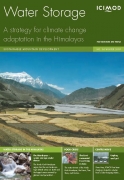/topics/glaciers-and-polar-ice-caps
Glaciers and Polar Ice Caps
Sensitivity analysis of melt runoff due to temperature and precipitation – A research report by National Institute of Hydrology
Posted on 06 Jul, 2010 11:36 PMThe study aims to assess the impacts of various climate scenarios on the hydrological response of the high altitude Spiti river in the Himalayas. The climatic scenarios were constructed on the basis of simulations of the Hamburg coupled atmosphere-ocean climate model for the study region.
Snow cover estimation in Himalayan basins using remote sensing: A research report by National Institute of Hydrology
Posted on 21 Jun, 2010 04:37 PMThe study estimates the snow cover area for four major basins in the Himalayan region viz. Chenab up to Akhnoor, Ganga up to Devprayag, Satluj up to Bhakra and Beas up to Pandoh using IRS - IC and ID WiFS data. Snow cover estimation was done for the years 1997-2000 using image processing system ERDAS Imagine. The maximum and minimum snow cover extent for the month of September-October and March-April were delineated and on the basis of these the depletion curves for each basin was made for the four years. This output is useful for carrying out snowmelt runoff modeling.
Water Storage: A strategy for climate change adaptation in the Himalayas - A report by ICIMOD
Posted on 10 Apr, 2010 05:24 PM This report by the International Centre for Integrated Mountain Development (ICIMOD) highlights the phenomenon of climate change and argues that water storage will be a key strategy for climate change adaptation in the coming years.
This report by the International Centre for Integrated Mountain Development (ICIMOD) highlights the phenomenon of climate change and argues that water storage will be a key strategy for climate change adaptation in the coming years.
The report discusses the importance of the Hindu Kush Himalayan ranges as an important source of water to a large section of the population and warns of the impending crisis of water scarcity and food insecurity in the regions of Asia, if water harvesting and conservation efforts are not undertaken. The document argues that water storage thus becomes a central issue, which is very complicated to implement, particularly in the Hindu Kush Himalayan region.
The Himalayan glaciers controversy - An article in Ground Report India
Posted on 01 Mar, 2010 03:36 PMA huge controversy has been generated in recent days over the much quoted lines in the IPCC’s 2007 report: “Glaciers in the Himalaya are receding faster than in any part of the world and, if the present rate continues, the likelihood of them disappearing by the year 2035 and perhaps sooner is very high if the Earth keeps warming at the current rate” (Working Group 2, page 493). We do need to question how a statement of such magnitude, without peer review, made its way into the IPCC report. That it was discovered,externally, more than two years later raises concerns about both the mindset and the weakness of the processes of the IPCC in checking and correcting information they collate, information that is so vital in the global debate. However, to question the credibility of the science of the global warming, supported as it is by a wealth of empirical evidence, or to question IPCC’s work, as is happening in some quarters, is gross exaggeration and sometimes driven by dubious and malafide intentions.
Monthly magazine-Dams, Rivers & People, Sep-Oct 2009, Oct-Nov 2009, Dec 2009 - Jan 2010
Posted on 25 Jan, 2010 12:56 PM
Speakers and presentations at the IWMI : Bharat Sharma speaks on the use of GIS for estimating basin level water productivity
Posted on 07 Dec, 2009 02:25 AM

Findings of Basin Focal Project on the Indo-Gangetic basin
Posted on 02 Dec, 2009 02:34 PMNo! This title isn't mine. I borrowed it from Mahmoud Darwish's literary work of the same name.
Effect of climate change on river Kosi and its basin
Posted on 28 Aug, 2009 02:46 PMKosi is one of Ganga's largest tributaries and in turn is fed by 7 tributaries - Sun Koshi, Dudh Koshi, Indravati, Tama Kosi, Likhu, Arun, and Tamar. These tributaries encircle Mt Everest from all sides and are fed by world's highest glaciers. The river drains a total area of 69,300 sqkm upto its confluence with Ganga. The river basin stretches 54,000 sq.kms.
Effect of climate change on the Ganga-Brahmaputra delta regions
Posted on 28 Aug, 2009 02:28 PMThe delta belt is home to approximately 125-140 million people. And over 300 million people are supported by the delta. The density of population in the Delta region is 200 people / sq.km. making it one of the densest regions in the world.
The delta region is a high-rainfall region and receives 60-80 inches of rainfall every year.
Quick reference: Climate change impacts on freshwater ecosystems in the Himalayas (CCIFEH)
Posted on 26 Aug, 2009 04:01 PMThe programme entails a panorama of actions working towards understanding future climate change impacts on Himalayan river ecosystems and vulnerable communities for the development of adaptation strategies; implementation of pilot sites; and raising the awareness of climate change impacts on Himalayan river basins, in addition to urging specific adaptation strategie





